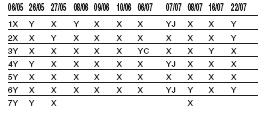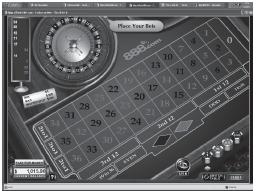You’ve probably heard me mention Mr Tefal Head (aka The Sequencer) and his strategy before. In fact we’re currently beta testing this approach with a dozen WRWM guinea pigs! Well today I wanted to give you an introduction to the concept of sequencing and its application to horseracing and other betting opportunities.
So what is Sequencing? The Sequencer puts it simply in the following equation:
“Sequencing = Probability + Averages + Random Numbers.”
Confused? Let me give you a familiar example.
Based upon past results we know that favourites will win about 30% of the time. And it’s this familiar statistic that forms the cornerstone of the sequencing methodology. Working with this statistic, we can predict, with an element of accuracy, when a favourite in a certain race is more likely to win the next race, based upon previous runnings. Let me give you a recent example. In the 5th race at Haydock, the favourite has only won 3 times in the last 15 meetings, and has not won in the last 10 meetings. The likelihood that a favourite will win in the next few races increases dramatically with each new meeting at Haydock.
So how do we take this knowledge and apply it
to our betting? With our current sequencing trial, we are betting to 2.5% of the betting bank level stakes. Because the favourite has not won in his last 10 runnings we can, alternatively, apply a progressive staking system to the next favourite in race 5 at the next meeting at Haydock, until a favourite obliges and redresses the balance 
In the above table, the X represents a losing favourite and the Y represents a winning favourite. The race numbers work from top to bottom, race 1, race 2, race 3, race 4, race 5, race 6 and race 7.
Looking at race 5, can you see that from the 6th May meeting up to the last meeting at Haydock, the favourite has lost in every race. At Haydock, a favourite has gone no more than 7 races without winning. From the next meeting at Haydock onwards, we can confidently back the favourite in race 5, knowing a correction is imminent, maybe not at the next meeting, but it is imminent.
In race 5 on 10th August 2006, the favourite, priced at 3/1 was beaten by a neck into 2nd place. In the 5th race on 11th August 2006, the joint favourites at 10/3 came 1st and 2nd.
This winning favourite redresses, to some extent, the balance. From a progressive staking perspective, we would have backed the favourite who came 2nd, at 3/1 to win a predetermined amount. That favourite lost. So we now back the next favourite (joint favourites) to win back our lost stake on the previous race and our new target profit.
The problem with random events is … they’re random!
OK, so we know that, on average, a favourite will win 1 in 3 races, but this is where randomness comes in. The problem is when? This random aspect of the equation can be negated if we wait, as with the above example, for an opportunity where the favourite has not won in some considerable time on a particular race. Having not won in the last 10, surely the favourite must oblige soon in race 5?
TIP – the longer the sequence, the more accurate our future predictions can become!
This is a basic introduction to sequencing as it relates to horse racing. There are other elements which must be considered in formulating a sequencing bet. But to give away all The Sequencer’s knowledge would put him out of work! We are currently putting The Sequencer’s powers of statistical analysis to the test with a handpicked selection of WRWM guinea pigs! Look out for more info very soon…
SEQUENCING AND ROULETTE:
Sequencing is ideally suited to games such as roulette. Here’s one such system:
Starting with a $200 betting bank (you can get this amount from http://www.888.com/ by depositing $200, where you immediately get a bonus of $200).
Go to an online casino such as http://www.888.com/
This is the roulette screen. We are interested in the 2/1 bets and the columns that begin 1, 2 & 3 and end 34, 35 & 36.
We will be betting on these columns, so get yourself a notepad and paper.
Draw 3 columns and title them 1-34, 2-35 and 3-36.
Now without betting, press the Spin button and place an X under the column which contains the winning number. Eg: 20 comes up, so we place an X under the 2-35 column.
Continue spinning without placing a bet, until one of the columns hasn’t won for 5 rounds. Now begin placing your bets on that column by following the staking plan below, until that column produces a winner.
In the above screenshot, I have made $15 in less than 30 minutes using this method. Here are my actual columns.
STAKING PLAN
Bet 1 – 1
bet 2 – 2
bet 3 – 3
bet 4 – 4
bet 5 – 6
bet 6 – 9
bet 7 – 13
bet 8 – 20
bet 9 – 30
bet 10 – 45
bet 11 – 67
bet 12 – back to bet 1
bet 13 – back to bet 2 etc
This is the power of sequencing. It can be applied to odds/evens or red/black bets in roulette. The longer the sequential pattern we build up, the more confident we can be in the sequence ending. Cast your mind back to Haydock. This was a strong sequence – 10 favourites on the trot haven’t won on Race 5. Obviously if we only had a sequence of 3 losing favourites, this would be far too early in a sequence for us to build up a pattern.
SEQUENCING AND FOOTBALL:
Here’s a quick and easy use of sequencing for football. Using the Racing and Football Outlook or an online resource site such asError! Hyperlink reference not valid., the teams last 6 match performances will look something like this:
TEAM A WDWWDL TEAM B WWWDDD
Where W indicates a win, D indicates a draw and L indicates a loss.
We now score the last 6 matches thus:
For every win we allocate 1 point For every draw we allocate 0 For every loss we allocate -1 point.
TEAM A would have scored 1+0+1+1+0-1 = 2 points TEAM B will have scored 1+1+1+0+0 = 3 points.
The difference here is -1 point in favour of Team B which is the away team
Using the following table we can calculate the likely results:
+12 to + 5 points indicates a strong home win +4 to +2 points indicates a home win +1 to -2 points indicates a draw -3 to -5 points indicates an away win -6 to -12 points indicates a strong away win
In our example, the likelihood is for a draw in this match.
This is another simple application of sequencing, which used in conjunction with other research can point you the right direction. Incidentally, http://www.betdevil.com ’s football ratings include an element of sequencing in tandem with other indicators to give an accurate (and free) analysis of up and coming matches. Remember, we are currently trialing The Sequencer and hope to launch a full advisory service in the Autumn. Watch out for more details!




What’s up, just wanted to tell you, I loved this article.
It was funny. Keep on posting!